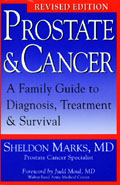Prostate & Cancer: A Family Guide to Diagnosis, Treatment & Survival
Author: Sheldon Marks, MD |
Dr. Marks is a prostate cancer specialist who received his training at Tufts University, the New England Medical Center, and the Mayo Clinic.He feels that, while much has been learned and written over the past few years about prostate cancer, there are no comprehensive sources ofinformation available for the layperson. As he states: "There are a few books about prostate cancer, but many of the patient's real questions areleft unanswered." This motivated him to write a book about prostate cancer in a unique question-and-answer format, answering over athousand questions most frequently asked by his patients. Dr. Marks states: "I wrote this book to empower and educate men and their familiesabout prostate cancer."
The author's style is what makes this book so informative and reader-friendly. It is divided into forty short chapters, ranging from two totwenty-one pages; he covers many topics, but not in an overwhelming manner. Each chapter begins with some background information, andthen proceeds to answer questions. Extremely important questions are highlighted to draw the reader's attention. If an answer to a question ismulti-faceted, he first lists the responses, then describes each individual response in more detail. This outline format makes it very easy to read.The author often inserts an "Author's Note" between the questions, where he provides an anecdote or a bit of advice to the reader.
Another thing to note about style is the excellent use of diagrams. The diagrams are easy-to-understand and incredibly helpful; they are usedthroughout the book to illustrate and outline the author's points. He even makes use of photographs (for example, to show what an ultrasoundprobe or a biopsy gun look like), ultrasound images, and bone scans. Everything on these images is clearly defined and explained, providing amore concrete image in the reader's mind than simply reading about these things would.
While style contributes tremendously to the value of this book, its content is also impressive. It is very comprehensive, providing informationon topics such as anatomy, diet, tests (such as the digital rectal exam, PSA blood test, ultrasound, etc.), treatments (such as radiation therapy,radical prostatectomy, etc.), dealing with family and friends, recovery and side effects, financial advice, and much more.
One very important chapter to note is entitled "Questions to Ask Your Doctor." It provides thirty-three important questions to help the readerbe an active participant in their health care. Other chapters to highlight are those covering treatments. Dr. Marks covers radiation (both externalbeam therapy and radioactive seed implants), lymph-node dissection, radical prostatectomy, hormone therapy and cryotherapy. He discussespros and cons of each treatment; he has clearly researched them well, and provides a fair analysis.
The book ends with a glossary, an appendix providing examples of consent forms and patient information often given out by doctors, abibliography, and an index. This book is highly recommended: it is incredibly easy to read and understand, while providing a comprehensivewealth of information. Dr. Marks does point out that "This book is intended to serve as a resource to give you a foundation for informeddiscussion about your health with your doctor. This is not intended to replace your physician..."
This book is an excellent resource and is highly recommended by OncoLink.


